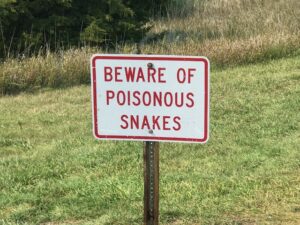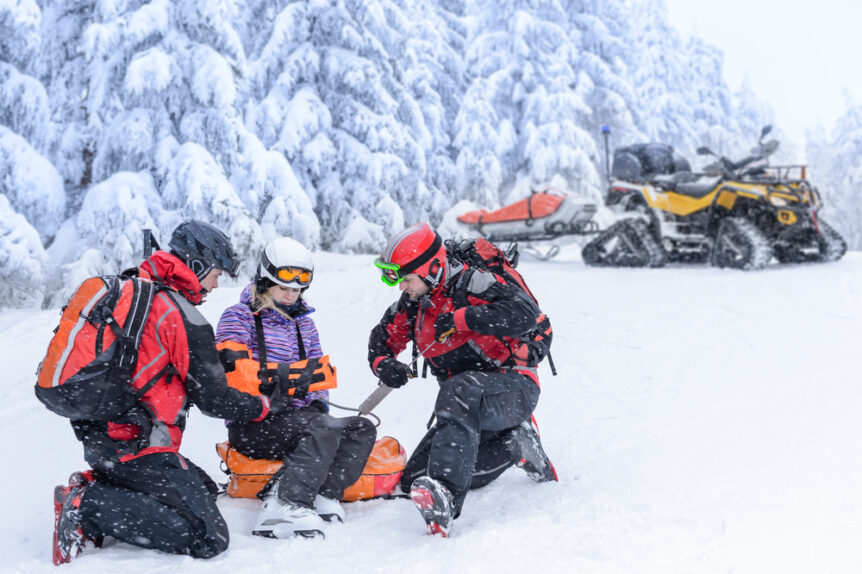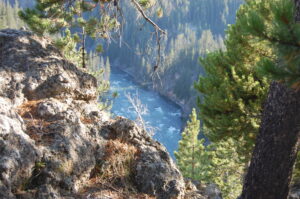This time of year, people love to be out hiking in cooler weather or participating in winter sports such as skiing, snowboarding, cross-country skiing and ice fishing.
Normally, nothing bad happens. But what if someone is unexpectedly injured? Like you cross paths with a bear, or miss a step and break your ankle? When humans wander out of their normal environments, danger literally lurks around every corner or tree. Even running a half-marathon in a hot, humid environment can cause hyperthermia or death if the runner isn’t physically prepared for it.
When someone is severely hurt though, a trained wilderness rescue team may be called. Depending on how remote the victim is, a doctor may even be on board.
An Appalachian Romance with a Wilderness Illness
A couple years ago, my friend & author Denise Hunter asked me to help with her contemporary clean romance, Mulberry Hollow, third in her Riverbend Series. Delighted to assist since I got a sneak preview, we set to work. Her heroine was a female doctor in the small mountain town of Riverbend, on the Appalachian Trail. The hero would be hiking the trail alone in honor of one of his fallen military brothers. He falls ill and goes into Riverbend for medical help. The heroine finds a feverish man on her clinic doorstep, and the romance begins.
For Denise’s plot purposes, we had to sort out how to make him sick, but not badly injured. This posed a fun challenge. He needed to be able to do physical jobs in the rest of the novel like carpentry to pay off his bill to the heroine, who needed an apartment remodeled. Respiratory illness wouldn’t work because he hadn’t been around anyone else along the trail. We mulled over tick bite diseases, but Rocky Mountain Spotted Fever has a fairly high fatality rate. The other difficulty was to give him an illness that could be treated in a local clinic and wouldn’t require him to be sent onto a regional medical hospital.
Writers who have characters injured or falling sick in wilderness settings–now called “Austere Conditions”– need to know what is common injury-wise and illness-wise (See my posts on Writing About Hyperthermia and Writing About Hypothermia). What kind of emergency medical help would be sent? How would your character self-treat if no help is available?
Denise settled on dehydration, and we went from there. In her local town clinic, the heroine gave the uninsured hero IV fluids and antibiotics. The hero amazingly lived to saw another day and of course, they fell in love.
If you like clean and wholesome contemporary romance, @DeniseAHunter is a superb author and her Riverbend Series is marvelous! Mulberry Hollow can be ordered at https://tinyurl.com/uzztjwve
If that’s not enough, her latest book in the series, Wildflower Falls, is out as well. http://tinyurl.com/5n7tur5w


What is Wilderness Medicine?
Wilderness Medicine is now an official sub-specialty of Emergency Medicine, or as I would put it, “Docs who go where the wild things are.” Some are now calling it “Austere Locations” instead, because any adverse-to-human environment such as desert, jungle, high mountain, Antarctica, polar location, deep ocean, space, skies, and caves are all austere places doctors might have to go to treat injured people.
One doctor spent an entire night in a tent anchored to a cliff in order to treat a badly injured mountain climber. The physician had to also be a mountain climber in order to rappel down to the patient and hook his gear up correctly.
Amazing dedication!
Two subspecialties linked to Wilderness Medicine are Aerospace Medicine (pilots and astronauts) and Bariatric Medicine, doctors who treat people with deep diving injuries.
Things can go great out in the wilderness, until you meet a bear or a misstep happens, and you’re stuck. Perhaps literally – with your ankle in a rock crevice. Or find yourself on a disabled boat in the middle of the ocean.
Who you gonna call? Not a local family doctor, unless he or she just lives up the road. They may be able to help in simple injuries and local rescues. Major accidents require the assistance of medical personnel with Wilderness Medicine training and experience. You may need mountain rescue, or desert rescue, or even marine rescue.
Or if you were on an expedition, your trip may have even included an expedition medicine doctor.
Our adult son, who at the time was doing a Master’s degree in Voice, attended a summer-long opera workshop in Crested Butte, Colorado. Crested Butte sits at an altitude of 8,000 feet. A few days in, he began experiencing shortness of breath, trouble getting enough air, and dizziness. He thought it was because of the exertion of singing in a high altitude, and he was partly right.
Our daughter-in-law took him to a local urgent care, and the doctor there quickly recognized the signs of possible HAPE, High Altitude Pulmonary Edema, and sent him by ambulance down the mountain to be treated at a lower-altitude hospital. Our son was treated, his symptoms resolved, and he took a preventive medication for the rest of the summer workshop.
Austere versus Austen?
When I started to write this article, I didn’t realize how often austere environments get used for blockbuster or dramatic action films. The dramatic environment alone can be the villain, or just pose challenges for the hero and villain as they spar or fight a common villain together.
For each of the following austere environments, list one or two famous films that come to mind. (There are no wrong answers.)
Ocean —
Desert–
Outer Space–
Jungle–
Animals–
High Mountains–
Cave–
Here are some I came up with.
Ocean: Titanic, The Perfect Storm (true story)
Desert: Lawrence of Arabia, Flight of the Phoenix, 127 Hours (true story)
Outer Space: Apollo 13 (true story), Gravity
Jungle: Jurassic Park, Jumanji, The African Queen
Dangerous Animals: Jaws, Jurassic Park
High Mountains: The Mountain Between Us, Into Thin Air (true story), Alive (true story)
Caves: The Cave (true story)
All kinds of stories and films use setting as drama. Infection by rabies figures prominently in the classic coming-of-age story, Old Yeller. Kate Winslet starred as a heroine doctor and CDC researcher in the movie Contagion (tough to watch this one after Covid) and she also played a surgeon in The Mountain Between Us.
In the Oscar-winning film, The African Queen, the characters not only fight the river, a waterfall, and the jungle but also leeches in the river. One of Humphrey Bogart’s finest performances, he won Best Actor Oscar. The conflict between Kate Hepburn’s character and Bogart’s is echoed by their struggle to survive the jungle and get to freedom during wartime.
Humans can be remarkably resilient and survive dangerous settings and scenarios, which is why so many films are based on actual accounts. Click To Tweet

Wilderness Injuries
These are just partial lists of things that can happen out in the wild, but can serve as a starting point for you the author to devise scenarios for your characters. Everything is on a spectrum – from a minor cut that could lead to a serious infection or not, to someone who has a minor tick bite which does nothing but then develops Rocky Mountain Spotted Fever.
Remember: anything that can happen at home—for example, a kidney stone, gallbladder attack, heart attack, stroke, or gastrointestinal illness, etc.—(unlike Vegas) doesn’t stay at home. It can happen in the wild, too. Click To TweetThis blog is arranged a little differently – Deeper Dive links for more specific things like tick bites and altitude sickness are included in the list.
Minor Wilderness Issues:
- Mild sprains and strains
- Blisters
- Small cuts (lacerations)
- 1st & 2nd degree burns – small area
- Rashes – prickly heat, hives, poison ivy, etc.
- Mild dehydration
- Chipped or broken tooth
- Mild frostbite/frostnip
- Altitude Sickness – Acute Mountain Sickness or AMS
- Insect bites – mosquito, chiggers, etc.
- Tick bites by themselves are minor, the diseases they can carry are not. It takes 36-48 hours of a tick being attached to transmit Lyme Disease.
- Closed, non-displaced fracture of hand, wrist or forearm (leaves you mobile) with no nerve or circulation issues
- Head injury with minor concussion
Serious Wilderness Issues:
- Any displaced or open fracture, or any fracture causing numbness or circulation issues
- Second degree burn or any combo of burns over a larger area, such as the entire back, or an arm or leg
- All of the above minor list, but more severe—for example, a tooth knocked out in a hemophiliac is a different situation and could provoke a life-threatening bleed
- Snakebite – from a “non-poisonous” snake (even though it’s still venomous, technically)
- Large laceration – lower-level tissues involved such as fat & tendons
- Allergic reactions controlled by medication and/or an Epipen
- Infections such as skin abscess, urinary tract infection because of dehydration, gastrointestinal illness with vomiting and diarrhea
The treatment of wilderness injuries will be based on the specific damage or issue. Overall, the same rules apply – scene safety (like are they still hanging upside down from a tree on a cliff), airway, breathing, circulation,… Click To Tweet
Life-Threatening Wilderness Issues:
- Venomous snake bites: https://www.mayoclinic.org/first-aid/first-aid-snake-bites/basics/art-20056681
- Severe hypothermia/frostbite: https://www.mayoclinic.org/diseases-conditions/frostbite/symptoms-causes/syc-20372656
- Deep lacerations involving an organ or body cavity or that exposes bone
- Ingestion of poisonous berries
- Fractures of pelvis, femur, upper arm, shoulder, hip, knee
- Crush injuries
- Shock due to any reason
- Altitude Sickness, either HAPE (high altitude pulmonary edema i.e. water in the lungs) or HACE (high altitude cerebral edema, i.e. brain swelling) https://my.clevelandclinic.org/health/diseases/15111-altitude-sickness
- Anaphylaxis (allergic reaction)
- 3rd degree burns, or 1st & 2nd degree over large areas
- Animal bites (listed here due to risk for rabies from bat, racoon or any rabid animal)
- Animal attacks – bears, mountain lion, etc.
- Hunting accidents, Gunshots (see https://novelmalpractice.com/writing-about-gunshot-wounds/
- Lightning strike
- Submersion, near-drowning
- Tick bite w/deadly diseases. For a general overall view, see https://www.cdc.gov/ticks/tickbornediseases/index.html or https://www.yalemedicine.org/conditions/tick-borne-illnesses
Rocky Mountain Spotted Fever: https://www.hopkinsmedicine.org/health/conditions-and-diseases/rocky-mountain-spotted-fever
Heartland virus https://www.prevention.com/health/a39464036/heartland-virus-lone-star-ticks/
Powassan https://www.cdc.gov/powassan/index.html
Babesiosis https://www.npr.org/2023/03/17/1164291434/babesiosis-tick-disease-northeast
Erlichiosis https://my.clevelandclinic.org/health/diseases/17958-ehrlichiosis
Author’s photo, Yellowstone River
Questions to Ask Yourself when Writing about Wilderness Medicine:
- Will all or just some of my characters be in that environment? Will the rescuers/medical personnel be major characters in the story or secondary? Will the rescuers come from somewhere else? Will I use more than one austere environment? Will a rescuer end up becoming a victim too?
- How long do I want my injured or ill character(s) to have to wait for medical care? Will someone expire before help can arrive?
- Do any of my characters have pre-existing diseases? For obvious reasons, underlying chronic illness puts anyone at greater risk for death in an austere environment. I have significant asthma and allergies – I didn’t do well on the top of Pike’s Peak! High blood pressure is a risk for heart attacks and strokes out in the wilderness. Osteoporosis would be a huge risk for fracture if the character trips or falls.
- Age as always, plays a big factor in wilderness survival. The very young and the frail elderly may live if rescued quickly. They don’t have the bodily defenses to survive severe heat, cold, bleeding injuries, head wounds and fractures. Neither group has a nice muscle and fat layer for protection, and their immune systems are impaired so they’re at greater risk for infections.
- Is your character immunosuppressed (i.e. on steroids, chemotherapy, had recent radiation, has cancer, or has an immune disease)? These will make them more susceptible to infection, pneumonia, etc. from simple injuries or exposure.
- What are the environmental conditions? Temperature, wind speed, wind chill, altitude, wet or dry, open & exposed area or is shelter available? The harsher the weather, the more serious any injury or illness will become. More temperate environments, such as the jungle, can lead to higher chances of survival . . . so long as no anacondas are around.
- Are food and water available? The biggest challenge for anyone in the wilderness is drinkable water and food with enough calories to sustain survival.
EVEN MORE questions to ask yourself!
- Is your character an “always prepared” Eagle Scout type, or a hapless fellow who decided to learn how to rock climb on a real cliff over the weekend?
- Does this character have training in emergency medicine, or have they taken courses? Did they bring a simple first aid kit, an advanced ATLS (Advanced Trauma Life Support) kit?
- Is your character drug- or alcohol-impaired? This will slow their responses and reflexes. In particular, alcohol causes vasodilation, which is not what you want. The person will feel a warm flush with the alcoholic drink but the dilation of the blood vessels actually puts them in harm’s way because hypothermia will come on faster.
- Are they wilderness-aware? Someone who hunts regularly or has undergone survival training will be far more prepared to deal with a wilderness injury than your average Joe.
- Does anyone know where they are or not?
- Can they communicate to reach help or not?
- How far are they from a trauma center? For example, is there a medical center with wilderness-trained personnel nearby? Or is air transport available close by, and what kind (fixed-wing or helicopter)?
RFDS, Royal Flying Doctor Service
I recently discovered a great medical series, “RFDS, or Royal Flying Doctor Service,” on PBS Masterpiece Theater. A drama about the real Australian Outback RFDS, so far, in the first two seasons, it’s almost 100% medically correct. If you want drama plus medical procedures on a high level, both altitude and writing-wise, this is the show for you. It’s amazing how many emergency events they pack into one episode.
Hubby and I only spotted one minor flaw. The doctor relieves air/blood from a tension pneumothorax/hemothorax, and the amount removed was about 5 cc. That seemed too little for the dramatic relief shown by the patient. Hey, it’s television.
Deeper Dives:
HAPE https://www.healthline.com/health/high-altitude-pulmonary-edema
“Wilderness Medicine” article in the World Journal of Emergency Medicine: https://www.ncbi.nlm.nih.gov/pmc/articles/PMC4129861/
Wilderness Medical Society https://wms.org/
NOLS https://www.nols.edu/en/wilderness-medicine/why-nols
(NOLS has a great blog written by their trained professionals. NOLS offers certification for medical professionals besides physicians.



